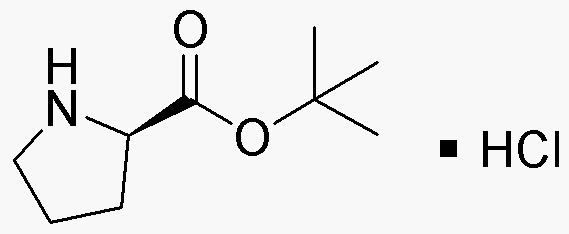D-Proline tert-butyl ester hydrochloride is widely utilized in research focused on:
- Peptide Synthesis: This compound serves as a valuable building block in the synthesis of peptides, particularly in creating cyclic peptides that are essential in drug development.
- Chiral Auxiliary: It acts as a chiral auxiliary in asymmetric synthesis, helping chemists produce enantiomerically pure compounds, which are crucial in pharmaceuticals.
- Biochemical Research: Researchers use it to study protein folding and stability, providing insights into diseases related to protein misfolding.
- Drug Development: Its role in modifying drug structures enhances bioavailability and efficacy, making it a key player in the pharmaceutical industry.
- Material Science: The compound is explored in the development of novel materials, including polymers that exhibit unique properties for various applications.
General Information
Properties
Safety and Regulations
Applications
D-Proline tert-butyl ester hydrochloride is widely utilized in research focused on:
- Peptide Synthesis: This compound serves as a valuable building block in the synthesis of peptides, particularly in creating cyclic peptides that are essential in drug development.
- Chiral Auxiliary: It acts as a chiral auxiliary in asymmetric synthesis, helping chemists produce enantiomerically pure compounds, which are crucial in pharmaceuticals.
- Biochemical Research: Researchers use it to study protein folding and stability, providing insights into diseases related to protein misfolding.
- Drug Development: Its role in modifying drug structures enhances bioavailability and efficacy, making it a key player in the pharmaceutical industry.
- Material Science: The compound is explored in the development of novel materials, including polymers that exhibit unique properties for various applications.
Documents
Safety Data Sheets (SDS)
The SDS provides comprehensive safety information on handling, storage, and disposal of the product.
Product Specification (PS)
The PS provides a comprehensive breakdown of the product’s properties, including chemical composition, physical state, purity, and storage requirements. It also details acceptable quality ranges and the product's intended applications.
Certificates of Analysis (COA)
Search for Certificates of Analysis (COA) by entering the products Lot Number. Lot and Batch Numbers can be found on a product’s label following the words ‘Lot’ or ‘Batch’.
Número de catálogo
Número de lote/lote
Certificates Of Origin (COO)
This COO confirms the country where the product was manufactured, and also details the materials and components used in it and whether it is derived from natural, synthetic, or other specific sources. This certificate may be required for customs, trade, and regulatory compliance.
Número de catálogo
Número de lote/lote
Safety Data Sheets (SDS)
The SDS provides comprehensive safety information on handling, storage, and disposal of the product.
DownloadProduct Specification (PS)
The PS provides a comprehensive breakdown of the product’s properties, including chemical composition, physical state, purity, and storage requirements. It also details acceptable quality ranges and the product's intended applications.
DownloadCertificates of Analysis (COA)
Search for Certificates of Analysis (COA) by entering the products Lot Number. Lot and Batch Numbers can be found on a product’s label following the words ‘Lot’ or ‘Batch’.
Número de catálogo
Número de lote/lote
Certificates Of Origin (COO)
This COO confirms the country where the product was manufactured, and also details the materials and components used in it and whether it is derived from natural, synthetic, or other specific sources. This certificate may be required for customs, trade, and regulatory compliance.

